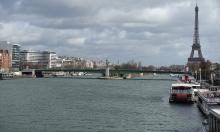The DNA of Mona Lisa's smile
On September 27, the Swiss Foundation of Mona Lisa presented a painting that, presumably, is an early version of the "Mona Lisa" by Leonardo da Vinci. On October 3, Italian archaeologists reported that they discovered the tomb of Mona Lisa. In July of this year, in the Ursuline convent in Florence the remains of five women were found.

To date a burial where two skeletons were buried has been excavated. In the middle of the 16th century only two great ladies were buried - Lisa Gherardino and Maria del Riccio.
Isleworth-Mona-Lisa, named after the London suburb Isleworth where British collector Hugh Blaker lived in the early 20th century, was perhaps the unfinished early version of Leonardo's masterpiece stored in the Louvre. Shortly before World War I, Blaker sold the canvas to another collector, Earl Brownlow of Somerset. During the World War II, this "version" of "Mona Lisa" was taken to the Boston Museum of Fine Arts, and then it changed owners several times. During the last 40 years the painting was in the safe of a Swiss bank.
In 2010, in Zurich the Foundation for the Mona Lisa was created, whose members decided to prove that the picture was painted by Leonardo. To this end, numerous art history examinations were performed, including radiocarbon analysis. According to current research, Leonardo da Vinci began writing his famous "Mona Lisa" in 1503. In 1955 an exhibition was organized in Paris where dozens of copies and fakes of the cult masterpiece were exhibited. Some of them, especially those in Madrid Prado Museum, are better known to the public, others - less.
Among other things, the examination was complicated by the fact that the student and lover of Leonardo named Gian Giacomo Caprotti nicknamed Salai, drew pictures in parallel with the master. A famous American scholar and art historian Deborah Dixon (1909-1994) presented a very compelling case for the fact that even the Louvre only had a copy of the "Mona Lisa."
Expert opinions, as usual, are divided. Some have confirmed that the two paintings were painted by Leonardo da Vinci, while others expressed the hypothesis that "Isleworth Mona Lisa" is later a copy of "Mona Lisa." Some believe that the evidence against Leonardo's authorship is the fact that it is written on a canvas, while the master preferred to write on wood. The portrait of "Mona Lisa" from the Louvre (70 centimeters in height and 53 in width) is made on a poplar board.
There are other differences as well. "Isleworth Mona Lisa" is bigger and was created ten years before its namesake from the Louvre. Here the experts refer to the historical evidence that shows that the Italian painter left unfinished the first copy of the canvas where the Mona Lisa was displayed between the columns.
Meanwhile, Italian archaeologists have discovered a skeleton and two skulls. Judging by the folded arms, the body lay in a coffin or sarcophagus. Near the burial there were the remains of an earlier burial. The remains were found at the base of the altar of the 15 century witht the symbol of Gherardini to which Lisa Gherardini, the legendary "Mona Lisa," belonged. She was the wife of a wealthy Neapolitan merchant Francesco del Giocondo who had a successful business in Florence. The best-preserved skeleton belongs to a tall young woman. Mona Lisa at the time of the portrait was not older than 22, though she has given birth to two children.
"If everything goes as planned, in this part of the monastery we will find Gherardino. Her skull, thanks to modern technology, will help us to reconstruct her face," said to Euronews TV channel Silvano Vinceti, Professor .of the Italian National Committee for Cultural Heritage. Then we can compare that person with a portrait of the Mona Lisa and then, perhaps, for the first time we will get an answer based on modern technologies. We are almost certain that all the remains are from the 16th century. We have found in the archives that this is the crypt of the Franciscan friars. Lisa Gherardino's daughter was a nun of the Order, so her mother, known as the Mona Lisa, was allowed to be buried here."
A little deeper and to the left there is another burial. The researchers hope to get to it next week. The results of the DNA decoding, and therefore, confirmation (or rebuttal) of the fact whether this is the burial of the Mona Lisa will become known no earlier than in the spring of next year.
Igor Bukker
Pravda.Ru
Subscribe to Pravda.Ru Telegram channel, Facebook, RSS!




